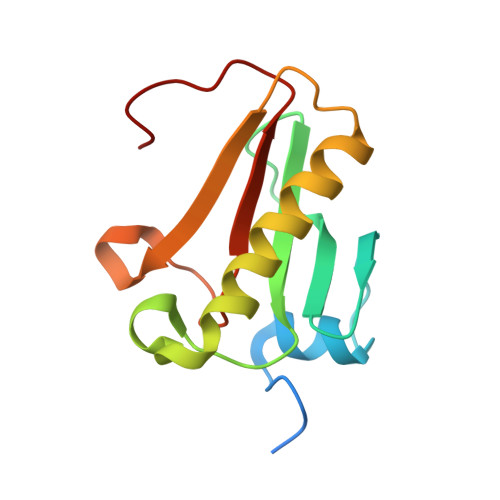Inhibition by divalent metal ions of human histidine triad nucleotide binding protein1 (hHint1), a regulator of opioid analgesia and neuropathic pain.
Shah, R., Chou, T.F., Maize, K.M., Strom, A., Finzel, B.C., Wagner, C.R.(2017) Biochem Biophys Res Commun 491: 760-766
- PubMed: 28739258
- DOI: https://doi.org/10.1016/j.bbrc.2017.07.111
- Primary Citation of Related Structures:
5EMT - PubMed Abstract:
Human histidine triad nucleotide binding protein 1 (hHint1) is a purine nucleoside phosphoramidase and adenylate hydrolase that has emerged as a potential therapeutic target for the management of pain. However, the molecular mechanism of Hint1 in the signaling pathway has remained less clear. The role of metal ions in regulating postsynaptic transmission is well known, and the active site of hHint1 contains multiple histidines. Here we have investigated the effect of divalent metal ions (Cd 2+ , Cu 2+ , Mg 2+ , Mn 2+ , Ni 2+ , and Zn 2+ ) on the structural integrity and catalytic activity of hHint1. With the exception of Mg 2+ , all the divalent ions inhibited hHint1, the rank of order was found to be Cu 2+ >Zn 2+ >Cd 2+ ≥Ni 2+ >Mn 2+ based on their IC 50 and k in /K I values. A crystal structure of hHint1 with bound Cu 2+ is described to explain the competitive reversible inactivation of hHint1 by divalent cations. All the metal ions exhibited time- and concentration- dependent inhibition, with the rate of inactivation highly dependent on alterations of the C-terminus. With the exception of Cu 2+ ; restoration of inhibition was observed for all the metal ions after treatment with EDTA. Our studies reveal a loss in secondary structure and aggregation of hHint1 upon incubation with 10-fold excess of copper. Thus, hHint1 appears to be structurally sensitive to irreversible inactivation by copper, which may be of neurotoxicological and pharmacological significance.
Organizational Affiliation:
Department of Medicinal Chemistry, University of Minnesota, Minneapolis, MN 55455, USA.















